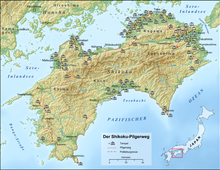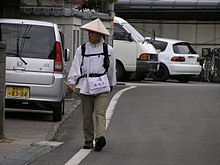The Shikoku Pilgrimage (四国遍路, Shikoku Henro) or Shikoku Junrei (四国巡礼) is a multi-site pilgrimage of 88 temples associated with the Buddhist monk Kūkai (Kōbō Daishi) on the island of Shikoku, Japan. A popular and distinctive feature of the island's cultural landscape, and with a long history, large numbers of pilgrims, known as henro (遍路), still undertake the journey for a variety of ascetic, pious, and tourism-related purposes.[1] The pilgrimage is traditionally completed on foot, but modern pilgrims use cars, taxis, buses, bicycles, or motorcycles, and often augment their travels with public transportation. The standard walking course is approximately 1,200 kilometres (750 mi) long and can take anywhere from 30 to 60 days to complete.







In addition to the 88 "official" temples of the pilgrimage, there are 20 bekkaku (別格) temples, which are officially associated with the Shikoku Pilgrimage (and hundreds more bangai (番外) temples, simply meaning "outside the numbers," which are not considered part of the official 88).[2][3] To complete the pilgrimage, it is not necessary to visit the temples in order; in some cases, pilgrims complete the journey in reverse, a practice known as gyaku-uchi (逆うち).[4]
Henro (遍路) is the Japanese word for pilgrim,[5] and the locals along the route address the pilgrims as o-henro-san (お遍路さん). They are often recognizable by their white clothing, sedge hats, and kongō-zue or walking sticks. Alms or osettai (お接待) are frequently given to pilgrims by Shikoku's residents.
Before reaching Temple 88, walking and bicycle pilgrims can receive a "Shikoku 88 Temple Pilgrimage Henro Ambassador" certificate from the Maeyama Ohenro Koryu Salon. At Temple 88, one can purchase a pilgrimage completion certificate called a kechi-gan-shō (結願証), meaning "fulfillment of one's wishes."[6] Many pilgrims also begin and complete the journey by visiting Mount Kōya in Wakayama Prefecture, which was settled by Kūkai and remains the headquarters of Shingon Buddhism. The 21 kilometres (13 mi) walking trail up to Kōya-san still exists, but most pilgrims use the train.[citation needed]
History edit
Background edit
Pilgrimages have played an important part in Japanese religious practice since at least the Heian period. Typically centred upon holy mountains, particular divinities, or charismatic individuals, they are usually to Buddhist sites although those to the shrines of Kumano and Ise are notable exceptions.[1][7]
Kōbō Daishi edit
Kūkai, born at Zentsū-ji (Temple 75) in 774, studied in China, and upon his return was influential in the promotion of esoteric Buddhism. He established the Shingon retreat on Kōya-san, was an active writer, undertook a programme of public works, and during visits to the island of his birth is popularly said to have established or visited many of its temples and to have carved many of their images. He is posthumously known as Kōbō Daishi.[8][9]
Development edit
The legends and cult of Kōbō Daishi, such as the episode of Emon Saburō, were maintained and developed by the monks of Kōya-san who travelled to expound Shingon and were active, along with other hijiri, in Shikoku.[10] In the Edo period, the policy of tochi kinbaku (土地緊縛) restricted and regulated the movement of ordinary people. Pilgrims were required to obtain travel permits, follow the main paths, and pass through localities within a certain time limit, with the book of temple stamps or nōkyō-chō helping to provide proof of passage.[11]
Practice edit
Stages edit
Shikoku literally means "four provinces", those of Awa, Tosa, Iyo, and Sanuki, reorganized during the Meiji period into the prefectures of Tokushima, Kōchi, Ehime, and Kagawa. The pilgrim's journey through these four provinces is likened to a symbolic path to enlightenment, with temples 1–23 representing the idea of awakening (発心, hosshin), 24–39 austerity and discipline (修行, shugyō), 40–65 attaining enlightenment (菩提, bodai), and 66–88 entering nirvana (涅槃, nehan).[12]
Equipment edit
The pilgrim's traditional costume comprises a white shirt (白衣, oizuru), conical Asian hat (すげ笠, suge-kasa), and staff (金剛杖, kongō-zue). This may be supplemented by a ceremonial stole (輪袈裟, wagesa). The henro also carries a bag (頭陀袋, zuda-bukuro) containing name slips (納札, osame-fuda), prayer beads (数珠, juzu) (also known as nenju (念珠)), a booklet (納経帳, nōkyō-chō) to collect stamps/seals (朱印, shuin), incense sticks (線香, senkō), and coins used as offerings (お賽銭, o-saisen). The more religiously-minded henro may also carry a book of sutras (経本, kyōbon) and go-eika (ご詠歌) set with a bell.[13]
Rites edit
Upon arrival at each temple the henro washes before proceeding to the Hondō. After offering coins, incense, and the osame-fuda, the Heart Sutra (般若心経, Hannya Shingyō) is chanted along with repetition of the Mantra of the main image (本尊, honzon) and the Mantra of Light (光明真言, Kōmyō Shingon). After kigan and ekō (prayers and dedication of merit), the henro proceeds to the shrine of Kobo Daishi (大師堂, Daishidō). Coins and a fuda are similarly offered, and again the Heart Sutra is chanted, along with repetition of the Gohōgō Mantra, namu-Daishi-henjō-kongō.[13]
UNESCO World Heritage Bid edit
Since 2010, Shikoku's prefectural governments, NPO members, and local leaders have worked toward achieving UNESCO World Heritage status for the Shikoku Pilgrimage. Currently, it is recognized as a "Provisional Candidate" by Japan's Agency for Cultural Affairs, or a cultural asset which has not yet been added to Japan's World Heritage Tentative List but which should 'proceed with preparations.'[14]
Imitative versions edit
Attesting to the popularity of the Shikoku pilgrimage, from the eighteenth century a number of smaller imitative versions have been established.[7] These include a 150 kilometres (93 mi) circuit on Shōdo Island northeast of Takamatsu;[15] a 3 kilometres (1.9 mi) course on the grounds of Ninna-ji in Kyoto;[16] a route on the Chita Peninsula near Nagoya;[17] and circuits in Edo and Chiba Prefecture.[7] Outside Japan, another version is on the Hawai'ian island of Kaua'i.[18]
List of Main 88 Temples edit
Collectively, the 88 temples are known as Shikoku Hachijūhakkasho (四国八十八箇所).
List of 20 Bekkaku Temples edit
| Number | Temple Name | Location | Image |
|---|---|---|---|
| 1 | Taisan-ji (大山寺) | Kamiita, Tokushima | |
| 2 | Dōgaku-ji (童学寺) | Ishii, Tokushima | |
| 3 | Jigen-ji (慈眼寺) | Kamikatsu, Tokushima | |
| 4 | Yasaka-dera (八坂寺) | Kaiyō, Tokushima | |
| 5 | Daizen-ji (大善寺) | Susaki, Kouchi | |
| 6 | Ryuukou-in(龍光院) | Uwajima, Ehime | |
| 7 | Shusseki-ji(出石寺) | Oozushi, Ehime | |
| 8 | Eitoku-ji (永徳寺) | Oozushi, Ehime | |
| 9 | Monju-in (文珠院) | Matsuyama, Ehime | |
| 10 | Nishiyama Kouryuu-ji (西山興隆寺) | Saijou, Ehime | |
| 11 | Shouzen-ji (正善寺) | Saijou, Ehime | |
| 12 | Enmei-ji (延命寺) | Shikoku Chuuou, Ehime | |
| 13 | Senryuu-dera (仙龍寺) | Shikoku Chuuou, Ehime | |
| 14 | Joufuku-ji (常福寺) | Shikoku Chuuou, Ehime | |
| 15 | Hashikura-ji (箸蔵寺) | Myoushi, Tokushima | |
| 16 | Hagiwara-ji (萩原寺) | Kannon-ji city, Kagawa | |
| 17 | Kanno-ji (神野寺) | Man'nou, Kagawa | |
| 18 | Kaigan-ji (海岸寺) | Tadotsu, Kagawa | |
| 19 | Kouzai-ji (香西寺) | Takamatsu, Kagawa | |
| 20 | Ootaki-ji(大瀧寺) | Mima, Tokushima |
See also edit
- Shingon
- Kōyasan
- Japan 100 Kannon, pilgrimage composed of the Saigoku, Bandō and Chichibu pilgrimages.
- Saigoku 33 Kannon, pilgrimage in the Kansai region.
- Bandō 33 Kannon, pilgrimage in the Kantō region.
- Chichibu 34 Kannon, pilgrimage in Saitama Prefecture.
- Musashino Kannon Pilgrimage, pilgrimage in Tokyo and Saitama prefectures.
- Chūgoku 33 Kannon, pilgrimage in the Chūgoku region.
- Kannon
- Buddhism in Japan
- Tourism in Japan
- For an explanation of terms concerning Japanese Buddhism, Japanese Buddhist art, and Japanese Buddhist temple architecture, see the Glossary of Japanese Buddhism.
References edit
- ^ a b Reader, Ian (1999). "34. Legends, Miracles and Faith in Kōbō Daishi and the Shikoku Pilgrimage". In Tanabe, George J. (ed.). Religions of Japan in Practice. Princeton University Press. pp. 360–9. ISBN 0-691-05789-3.
- ^ "Map (In Japanese)". Shikoku Bekkaku 20 Pilgrimage Official Website. Retrieved 17 September 2022.
- ^ "Temples, Shrines, and Religions of Shikoku: Bekkaku Temples". Henro.org. Retrieved 17 September 2022.
- ^ "Shikoku Pilgrimage Guide". Shikoku District Transport Bureau. Retrieved 17 September 2022.
- ^ Reader, Ian (2005). Making Pilgrimages: Meaning and Practice in Shikoku. University of Hawaii Press, p. 318. ISBN 978-0-8248-2907-0
- ^ "The Shikoku Pilgrimage: What Happens at the End of My Pilgrimage?". Henro.org. Retrieved 17 September 2022.
- ^ a b c Kitagawa, Joseph M. (1987). On Understanding Japanese Religion. Princeton University Press. pp. 127–136. ISBN 0-691-10229-5.
- ^ Hakeda, Yoshito S. (1972). Kūkai: Major Works. Columbia University Press. ISBN 0-231-05933-7.
- ^ Miyazaki, Tateki (2004). Shikoku henro hitori aruki dōgyō-ninin. Matsuyama.
- ^ Reader, Ian (2005). Making Pilgrimages: Meaning and Practice in Shikoku. University of Hawaii Press. pp. 42ff. ISBN 978-0-8248-2907-0.
- ^ Kouamé, Nathalie (1997). "Shikoku's Local Authorities and Henro during the Golden Age of the Pilgrimage". Japanese Journal of Religious Studies. 24 (3/4). Nanzan University: 413–425. Archived from the original on 28 September 2014.
- ^ Reader, Ian (2005). Making Pilgrimages: Meaning and Practice in Shikoku. University of Hawaii Press. pp. 52f. ISBN 978-0-8248-2907-0.
- ^ a b Miyata, Taisen (2006). The 88 Temples of Shikoku Island, Japan. Koyasan Buddhist Temple, Los Angeles. pp. 15–18.
- ^ "Cultural properties on the World Heritage Tentative List". Retrieved 17 September 2022.
- ^ "Shodoshima Guide Book". Organization for the Promotion of Tourism in Shikoku. Retrieved 24 April 2011.
- ^ "Hachijūhakkasho". Ninna-ji. Retrieved 25 April 2011.
- ^ "Chita Hachijūhakkasho". Chita 88. Retrieved 25 April 2011.
- ^ "Lawai International Center". Retrieved 27 December 2014.
Further reading edit
- Dempster, Lisa (2009). Neon Pilgrim'. Footscray West, Vic.: Aduki Independent Press. ISBN 0-9803351-7-5.
- Lewis-Kraus, Gideon (2012). A Sense of Direction. New York: Riverhead Books. ISBN 978-1-59448-725-5.
- McLachlan, Craig (1997). Tales of a Summer Henro. Tokyo: Yohan Publications. ISBN 4-89684-257-X.
- Okamoto, Ryosuke (2019). Pilgrimages in the Secular Age: From El Camino to Anime. Tokyo: Japan Publishing Industry Foundation for Culture.
- Reader, Ian (2005). Making Pilgrimages: Meaning and Practice in Shikoku. Honolulu: University of Hawaii Press. ISBN 0-8248-2876-3.
- Sibley, Robert C. (2013). The Way of the 88 Temples: Journeys on the Shikoku Pilgrimage. Charlelottesville: University of Virginia Press. ISBN 978-0-8139-3472-3.
- Statler, Oliver (1983). Japanese Pilgrimage. New York: Morrow. ISBN 0-688-01890-4.
- Shennen, Wayne (2016). 88 and Forty: Walking Japan's Famous Shikoku Pilgrimage. Newblack Alchemy. ISBN 978-0-4733-7379-5.
External links edit
- (in English) About Shikoku Pilgrimage
- (in English) A Basic Guide to the Shikoku Pilgrimage (Japan National Tourism Organization)
- (in English) The Shikoku Henro World Heritage Inscription Council Office
- (in English) Documentary movie about the 88 Temple Pilgrimage